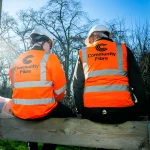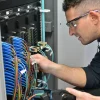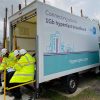Chairman of London Full Fibre ISP G.Network Resigns as Biz Seeks Turnaround UPDATE

Credible sources have informed ISPreview that the Chairman of London-focused UK ISP and broadband network builder G.Network, Sean Williams, has resigned after nearly five years in the post. The experienced chair is set to be replaced by Ian Gray, who appears to be a specialist in turning struggling businesses around.
Just to recap. G.Network previously committed an investment of around £1bn to help it deploy a new Fibre-to-the-Premises (FTTP / XGS-PON) broadband network across 1.3 million London premises by around the end of 2026. The last build update we had from them, which was in 2022, stated that they’d covered 400,000 premises. But independent checking has so far only been able to identify 255,000 premises as ready for service (here).
However, further doubts were cast over the viability of the operator’s rollout targets after they revealed, in May 2023, that around 230 jobs were due to be cut from the business (here) and more have since joined them. Thankfully, some good news emerged in July 2023 after the operator’s principal investor, USS, announced another investment boost of “up to an additional” £150 million to keep everything going (here).
Advertisement
The operator has also been going through some management changes and, according to several credible sources, the latest development has seen the resignation of their Chairman, an experienced industry veteran and former-BT leader, Sean Williams. According to our sources, Sean resigned to pursue his “other interests” (note: he’s also the Chairman of another AltNet, Grain Connect).
The move could be pre-planned because our sources indicate that they’ve already announced Ian Gray to be Sean’s replacement in the role. Ian’s LinkedIn profile (assuming we’ve got the right one) describes him as a “Chairman/CEO/Non-Executive with extensive hands-on international experience of start-ups, regeneration, improvement, growth and exit planning with operational, financial and strategic skills spanning a number of industry sectors.”
Back in 2015 Ian won the ‘Business Rescue of the Year‘ award from the aptly named Institute for Turnaround, and in 2013 he won a similar award as part of the Insolvency & Rescue Awards. Such skills should come in handy when navigating the currently challenging and aggressively competitive market for alternative UK full fibre networks, where warnings about future consolidation are beginning to loom large over more than a few players.
Residential customers of the service in London typically pay from £22 per month for a 150Mbps (50Mbps upload) package on a 24-month contract term (inc. £29 one-off installation fee), which rises to £48 for their top 1Gbps (symmetric) tier with free installation.
Advertisement
UPDATE 3:13pm
G.Network has released an announcement via their website, which includes a couple of comments.
Sean Williams said:
“G.Network is transforming London’s telecoms infrastructure and has a long bright future ahead. I am delighted to have played my part in its early years, but the time is right for me to move on at this stage.”
Kevin Murphy, CEO of G.Network, said:
“I am very grateful to Sean for his support and diligence in my first year at G.Network. Sean has been instrumental in the growth of the business and his wise counsel and industry expertise has helped us successfully navigate this start up and investment phase. We wish him all the very best for the future.”
Mark is a professional technology writer, IT consultant and computer engineer from Dorset (England), he also founded ISPreview in 1999 and enjoys analysing the latest telecoms and broadband developments. Find me on X (Twitter), Mastodon, Facebook, BlueSky, Threads.net and Linkedin.
« Cable Thieves Leave Oxfordshire UK Village Offline for Nearly 2 Weeks























































Hardly a surprise.
Let’s hope the new chair can stable the ship, without a doubt there will be other casualties but London needs a strong G. Network especially in the B2B space.
[Admin note: Please avoid making allegations against private individuals, which may stray into difficult legal territory]
Just how many actual customers (not premises passed) does G.Network currently have?
around 20k mix of B2B and B2C and some reseller
Given that as at 31 March 2022, G.Network reported property plant and equipment investments of £248m, 20k connections some 17 months later is looking exceptionally scant. Obviously wholesale can make a difference, but it’d need to be a very impressive number of wholesale connections.
If they have 255,000 premises passed as Ready For Service that’s only a 7.8% take up. If all 400,000 are ready it’s even worse. CityFibre are only up to 10% apparently. On the basis that the big 3 (BT/SKY/VIRGIN) have 2/3 of all customers and do not distribute via the altnets it leaves remains to seen if the altnets can take sufficient share to be viable.
They dug up the road outside my place in Inslington April 2020. Islington Council is the freeholder. Since then, nothing. While Hyperoptic and Community Fibre both have borough-wide way-leave agreements with Islington Council, G.Network do not. Is this incompetence on the part of G.Network, or a stitch up by the council?
Not a stich up. GN spent a fortune in terms of resources and hours applying for council wayleaves. And then under the new management they decided to bin off any new applications for them. So they won’t be doing Islington public housing.
there will be some MDU’s being done in Islington….
They’ve built lots between Clapham
Common and Brixton hill over the last 3 years – very little of it is live.
Digging up roads must be really expensive, it’s completely bizarre that you’d not want to get it connected or you’d dig somewhere you may be unable to fully deliver.
Alex
Alex
Anybody know equipment G.Network are using? PON like everyone else, or ethernet switches like Hyperoptic?
XGSPON
They use XGS PON kit from Nokia with OLT cabinets.
I am no expert but in my view turning it around will be tough. London is already well covered. I doubt there would be much of a market to wholesale it Merger or take over. Probably not particularly attractive. The only real value is getting the customer base but that pretty small so of little value
GN have some absolute prime ducted fibre in the centre of London that isn’t covered by anyone and likely won’t be, Id imagine thats why USS are battening down the hatches to ride out the financial environment right now.
Best outcome for me personally would be Cityfbre buying it up for the duct network and having some competent operator running the physical network.
@Jonny – Cityfibre aren’t spending anymore money until their take-up rates improve, that’s why they’ve stopped the majority of their builds.
Not a suprise. Fulham between Putney Bridge and Hammersmith is a poster child for how useless these firms are and the issues ahead. This area broadly had just FTC BT pre pandemic. Has a huge WFH population. G Network has spent 3 years digging up the northern half. Even once done, are back every month digging up for repairs. Illogical the council allows this level of disruption. South of New Kings road, no upgrades from anyone until two months ago when Community Fibre and Hyperoptic both switched on after using BT ducts, hence no disruption like G network. Now I have 3gbs CF and 1gb Hyperoptic for less than was paying BT for 120mbps. Meanwhile BT nowhere in site and didn’t even counter offer when I cancelled.
The council makes money from the permits they charge. Very easy to explain why a dumb incentive structure causes this
Its the Openreach B team recruited into a business with a bizarre and stupid business case building network where they are 3rd to the party.
Good luck turning around millions in wasted investment.
Like at least 50% of alt-nets
Having been a G.network customer before, I really hope they survive, although I do have my doubts. They definitely have their problems, but the connection is pretty good once you have their product installed.
I should add that in central London they cover large areas where BT simply is not interested at this point in time in even putting in FTTC let alone FTTP. Checking our old post code today shows that OR still have no plans to do anything despite the BT tower being literally meters away.
Sadly we have left central London and now live in the burbs. G.Network have ducts about 100m from our front door, however nothing in our new street. Personally I doubt they will ever build here as there are some unique challenges in our street – namely a non-standard footpath.
It’s fairly clear that consolidation is desperately needed in this industry. We don’t need to be passed by 2-3 additional alt-nets per property, and it would be better for 1 or 2 additional national players to exist beyond BT/OR and VMO2. Personally I would love the answer to be two, but I strongly suspect that any of the useful alt-nets will be merged into a single entity within the next 3-5 years. Having Ofcom force open the ability for all ISPs have the ability to plug into three or four or national physical networks would be transformational (BT/OR, VMO2 + X) for the UK.
I do keep wondering whether Vodafone/3 or Sky/Comcast will be the final owner of many of the viable alt-nets as both have the ability to raise the debt on the markets needed for the job. A VF/3 alt-nets merger specifically would allow the triple play services on home infrastructure, however it would not be beyond Sky (Comcast/NBC Universal) to also look to get into this space.
good post, and voda/3 sky etc would love to be able to have a full network they can own and operate…